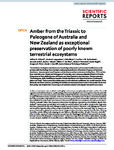Amber from the Triassic to Paleogene of Australia and New Zealand as exceptional preservation of poorly known terrestrial ecosystems
| dc.contributor.author | Stilwell, JD | |
| dc.contributor.author | Langendam, A | |
| dc.contributor.author | Mays, C | |
| dc.contributor.author | Sutherland, LJM | |
| dc.contributor.author | Arillo, A | |
| dc.contributor.author | Bickel, DJ | |
| dc.contributor.author | De Silva, WT | |
| dc.contributor.author | Pentland, AH | |
| dc.contributor.author | Roghi, G | |
| dc.contributor.author | Watanabe, Sayaka | |
| dc.contributor.author | Cantrill, DJ | |
| dc.contributor.author | Quinney, A | |
| dc.contributor.author | Peñalver, E | |
| dc.date.accessioned | 2020-04-30T10:03:47Z | |
| dc.date.issued | 2020-12 | |
| dc.identifier.issn | 2045-2322 | |
| dc.identifier.issn | 2045-2322 | |
| dc.identifier.other | 5703 | |
| dc.identifier.uri | http://hdl.handle.net/10026.1/15614 | |
| dc.description.abstract |
<jats:title>Abstract</jats:title><jats:p>The Northern Hemisphere dominates our knowledge of Mesozoic and Cenozoic fossilized tree resin (amber) with few findings from the high southern paleolatitudes of Southern Pangea and Southern Gondwana. Here we report new Pangean and Gondwana amber occurrences dating from ~230 to 40 Ma from Australia (Late Triassic and Paleogene of Tasmania; Late Cretaceous Gippsland Basin in Victoria; Paleocene and late middle Eocene of Victoria) and New Zealand (Late Cretaceous Chatham Islands). The Paleogene, richly fossiliferous deposits contain significant and diverse inclusions of arthropods, plants and fungi. These austral discoveries open six new windows to different but crucial intervals of the Mesozoic and early Cenozoic, providing the earliest occurrence(s) of some taxa in the modern fauna and flora giving new insights into the ecology and evolution of polar and subpolar terrestrial ecosystems.</jats:p> | |
| dc.format.extent | 5703- | |
| dc.format.medium | Electronic | |
| dc.language | en | |
| dc.language.iso | en | |
| dc.publisher | Nature Research (part of Springer Nature) | |
| dc.title | Amber from the Triassic to Paleogene of Australia and New Zealand as exceptional preservation of poorly known terrestrial ecosystems | |
| dc.type | journal-article | |
| dc.type | Journal Article | |
| dc.type | Research Support, Non-U.S. Gov't | |
| plymouth.author-url | https://www.webofscience.com/api/gateway?GWVersion=2&SrcApp=PARTNER_APP&SrcAuth=LinksAMR&KeyUT=WOS:000540495600001&DestLinkType=FullRecord&DestApp=ALL_WOS&UsrCustomerID=11bb513d99f797142bcfeffcc58ea008 | |
| plymouth.issue | 1 | |
| plymouth.volume | 10 | |
| plymouth.publication-status | Published online | |
| plymouth.journal | Scientific Reports | |
| dc.identifier.doi | 10.1038/s41598-020-62252-z | |
| plymouth.organisational-group | /Plymouth | |
| plymouth.organisational-group | /Plymouth/Faculty of Science and Engineering | |
| plymouth.organisational-group | /Plymouth/Faculty of Science and Engineering/School of Geography, Earth and Environmental Sciences | |
| plymouth.organisational-group | /Plymouth/REF 2021 Researchers by UoA | |
| plymouth.organisational-group | /Plymouth/REF 2021 Researchers by UoA/UoA07 Earth Systems and Environmental Sciences | |
| plymouth.organisational-group | /Plymouth/Research Groups | |
| plymouth.organisational-group | /Plymouth/Research Groups/Marine Institute | |
| plymouth.organisational-group | /Plymouth/Users by role | |
| plymouth.organisational-group | /Plymouth/Users by role/Academics | |
| plymouth.organisational-group | /Plymouth/Users by role/Researchers in ResearchFish submission | |
| dc.publisher.place | England | |
| dcterms.dateAccepted | 2020-02-25 | |
| dc.rights.embargodate | 2020-5-2 | |
| dc.identifier.eissn | 2045-2322 | |
| dc.rights.embargoperiod | Not known | |
| rioxxterms.versionofrecord | 10.1038/s41598-020-62252-z | |
| rioxxterms.licenseref.uri | http://www.rioxx.net/licenses/all-rights-reserved | |
| rioxxterms.licenseref.startdate | 2020-12 | |
| rioxxterms.type | Journal Article/Review |


